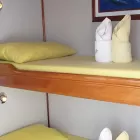After breakfast, sail to Santa Cruz Island, and visit the world-famous Charles Darwin Station, a non-profit institution that dedicates itself to studying and protecting the flora and fauna of the Galapagos. This is one of the best places to see land tortoises, including the Lonesome George Museum.
Then, visit the station’s Tortoise Rearing Center. Here you can find baby, hand-sized tortoises, between the ages of one and five, and marvel at how they achieve such large sizes as adults (500 lbs. or more!). Galapagos tortoises are believed to have a lifespan of over 100 years, so the young ones have a long life ahead of them as long as they receive the protection they need. Aside from the Station headquarters, Santa Cruz Island is home to the largest town and economic center of the Galapagos, Puerto Ayora. In this portside town, you can buy souvenirs (postcards, t-shirts, books, etc.) from the islands. Check out the unique Galapagos ceramic shop near the entrance of the Charles Darwin Station.
After shopping in Puerto Ayora and lunch on the boat (guests may dine in town if they desire), explore the highlands or “parte alta” of the island, which is a moisture-rich area with fertile volcanic soils. Learn about the vegetation and animal life of this zone, often strikingly different than that found at lower elevations, and the best opportunity to find the famous giant tortoises in their natural habitat. Darwin’s Finches, Yellow Warblers, and other land birds will fly in and out of the moss-covered trees. From this high vantage point, you are to be treated to beautiful views of the island. In the late afternoon, you’ll return to town. For those who wish to check out the nightlife, this is your chance; the boat docks in port most of the night.
Return to the boat. Dinner.

















